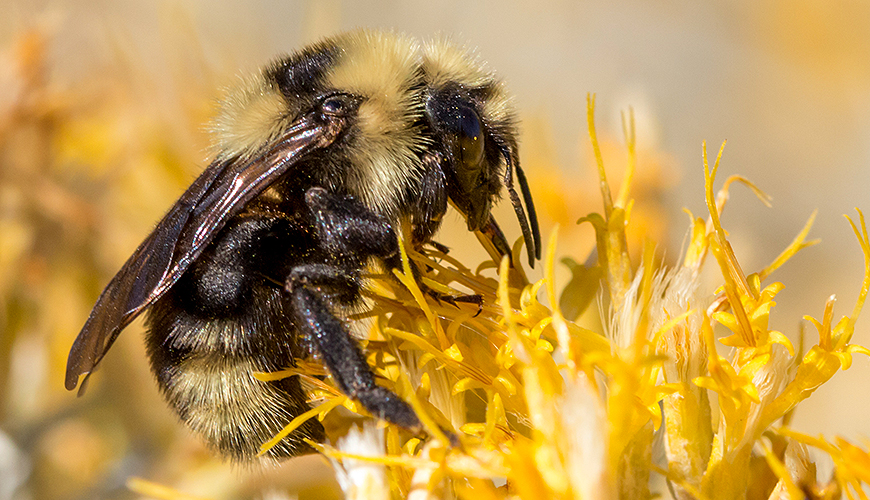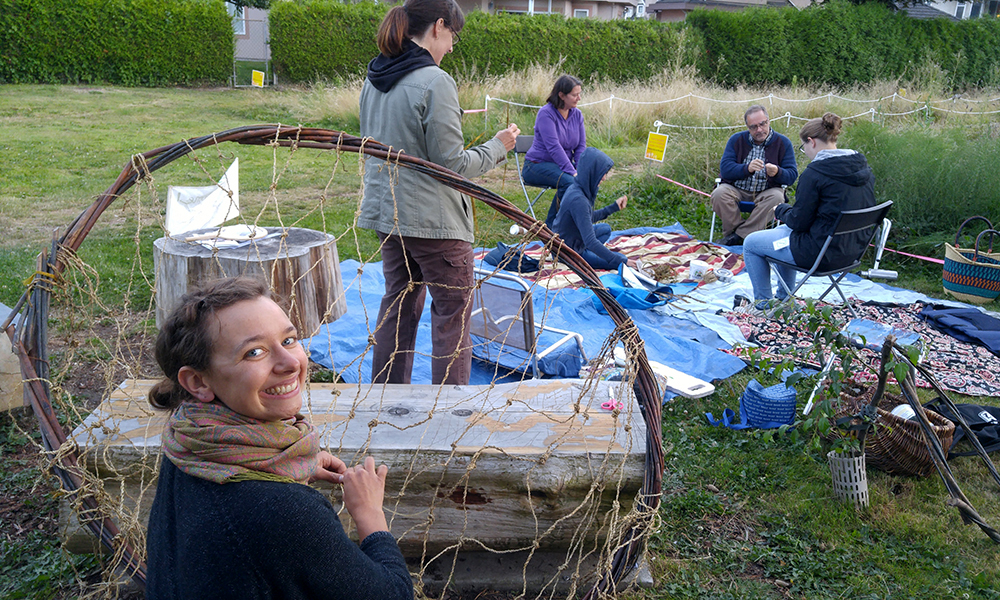
OLYMPUS DIGITAL CAMERA
ART, SCIENCE AND COMMUNITY IS A POWERFUL COMBINATION that helps improve our relationship with the natural world. And it is this combination and a focus on industrious little insects—bees—that’s resulting in community-driven partnerships.
Bees are keystone pollinators with an economic value of plant fertilization worldwide estimated in the hundreds of billions. The Okanagan is a hot spot of bee diversity, with more than 380 species abuzz in the valley. They are enchanting and charismatic creatures, the ultimate networkers.
A talk about bees can lead to a discussion about plants, which can quickly turn into a dialog about food, habitat, soil, air and water. Before you know it, a bee briefing can quickly turn into a conversation about an entire ecosystem.
That’s what inspired the Border Free Bees project run by Nancy Holmes, an associate professor of creative writing at UBC Okanagan, and Cameron Cartiere, the associate professor in the Faculty of Culture + Community at Emily Carr University of Art & Design.
Border Free Bees is an international public art initiative and public resource that focusses on native bees, raising awareness about pollinating insects and engaging communities to preserve and collectively create new habitats for pollinating allies.
“We work with gardening and conservation groups, public schools, university communities, kids, seniors, as many people as we can pull in,” says Holmes, an award-winning poet, writer, educator and researcher.
“It is inspiring to see the ripple effects into the community as more and more people are taking on their own pollinator projects.”
The Border Free Bees initiative has sparked dozens of projects in Kelowna and metro Vancouver: gallery shows, restorations of barren lands, outdoor community art events, indoor community education activities, the planting of nectar trails spanning several kilometres, an educational mobile app and the co-creation of pollinator habitats on small parcels of parkland.
One such project is the Kelowna Nectar Trail, a 7.4-km series of flowery havens that helps pollinators move safely through the urban landscape.
“Art is the driver as we get people together to care. Science provides the underpinning and community makes change happen. Bees engage everyone.”
Border Free Bees also garnered accolades for its engagement, including the 2017 Pollinator Advocate Award for Canada from the North American Pollinator Protection Campaign, a collaborative body of more than 160 scientists, researchers, conservationists, government officials and volunteers focused on pollinator protectionism. Holmes was named UBC Okanagan’s 2018 Researcher of the Year in Social Sciences and Humanities.
“Art is the driver as we get people together to care. Science provides the underpinning and community makes change happen,” she says. “Bees engage everyone.”
Bee I.D.
More than 70,000 species of bees belong to a handful of Apoidea families. Here are four of them. All photos by UBC Okanagan Biology prof Bob Lalonde.

Within the superfamily Apoidea, bumble bees belong to the largest family, Apidae, which contains at least 5,700 species.

Agapostemon (a.k.a. “sweat bees”) belong to Halictidae, the second largest family. According to Assoc. Prof. Nancy Holmes, they are “the most glorious bee of the valley.”

Leafcutters are part of the third largest family, Megachilidae, along with the “super pollinators” of fruit trees, mason bees.

Unlike their Apidae family members — social honey and bumblebees that live in large colonies — longhorn bees are solitary ground-nesters.

Commonly known as mining bees, in the Andrenidae family, miners like sandy or loamy soil and nest underground.

Pollen baskets on the hind legs of some bee species carry the microscopic grains back to the nest or hive.

UBC Okanagan profs Nancy Holmes and Denise Kenney joined others in Cyprus to incubate eco-art practices.
Eco Art Incubator: Fostering art and place for the ecosystem
Nancy Holmes certainly isn’t alone in eco-art endeavours. She’s found a great collaborator just down the hallway from her office, interdisciplinary performance Assoc. Prof. Denise Kenney. Together, Holmes and Kenney created the Eco Art Incubator, a research-focussed umbrella that supports students and artists in creating community-based art projects.
“Through the Eco Art Incubator, we became context providers rather than content providers,” says Kenney. “We create opportunities for people to share their respective strengths and perspectives through art.”
The Daylighting the Classroom project is a perfect example. Kenney and Holmes were approached by students and a science teacher at École KLO Middle School who were committed to restoring a Western Painted turtle habitat on school property. The students needed to raise $100,000 to get the job done.
Through the Eco Art Incubator, the profs connected the middle school to Shimshon Obadia, an ambitious undergraduate student majoring in interdisciplinary performance.
The connection evolved into a two-year project whereby Shimshon facilitated the production of eco-art initiatives to raise awareness and funds for the turtle habitat restoration and developed a framework for educators that show how science, art and nature can be used to teach children.

Cyprus Sites Embodied, 2017
In April 2017, Holmes and Kenney were invited to Cyprus Sites Embodied, an international ecology, environment and arts festival on the Akamas peninsula in the Mediterranean, as part of the Paphos 2017 European Capital of Culture. The intent was to seed similar practices of incubating eco-art practices in this area and to find other ways to have a conversation about place, and about issues confronting that place.
“Having an umbrella organization has proved to be a kind of a beacon. The title Eco Art Incubator holds within it it’s very meaning. So when people hear that, they understand this is a place they can incubate their ideas and make things happen,” says Kenney. “It is an entity that is self-defining and self-perpetuating.”

Nature Itself is the Best Educational Tool
Interdisciplinary Performance student Shimshon Obadia was recruited in 2013 to engage in a habitat re-naturalization project through creative solutions.
Using eco art to help raise awareness and funds, the UBC Okanagan undergraduate helped restore a turtle habitat with students from the École KLO Middle School in Kelowna.
After five years of dedicated work, all of their efforts paid off.
Working with FCCS professor Denise Kenney, Obadia created a documentary focusing on the tireless efforts of the students, who successfully saved the turtles’ natural environment.
SEE MORE ABOUT SHIMSHON

Cultural Studies students Tessa Baatz and Emma Mcleod, centre, present their Parklet project in class.
Community Engaged Research
Students in Cultural Studies focus on community engagement, working in collaborative teams to complete projects that support the work of community partners.
Professor David Jefferess has set up partnerships with Sncəwips Heritage Museum, the Ki-Low-Na Friendship Society, the Okanagan Wine and Orchard Museum, the Alternator Centre for Contemporary Art, and Lake Country’s Municipal Planning Office, Museum, and Public Art Commission.
Students are able to work on research projects in the areas of heritage and commemoration, community outreach and engagement, and education towards reconciliation, with topics that include colonial history and Indigenous resistance/resilience, the history of water “management” in the region, Japanese-Canadian Settlement, public and natural art, and artist communities.
In 2017, the students worked on some interesting and informative projects that demonstrate the skills they developed and the positive impacts they were able to make with their community partners.
Students Kezia Elaschuk and Safeera Jaffer researched the experiences of early Chinese and Japanese agricultural workers in the Okanagan. They presented their finding in an exhibition at the Okanagan Wine and Orchard Museum. The exhibit highlighted contributions of early immigrants.
“Parklets are a unique and completely feasible initiative towards reclaiming public space for building community spirit, an eco-friendly urban design and a people-centered city living.”student Emma McLeod
Tessa Baatz, Chiara Mason and Emma McLeod presented an idea to the City of Kelowna that examines the positive impacts of parking spaces that are reclaimed for public recreational or beautification purposes.
The goal of Parklets: Innovations in Public Space is “call to attention to the need for more urban open space, to generate critical debate around how public space is created and allocated, and to improve the quality of urban human habitat.”
The students formally presented the report to city staff but were told implementation of the report’s proposals will require community advocacy. The research was commissioned by Christian Brandt, co-founder and executive director of Ogo Car Share Co-Op.
“With this project we wanted UBC Okanagan students to look differently at streets, how to re-model them and how to create a better city,” Brandt says.
“We hope their report serves as a guiding document for the City of Kelowna to better understand the positive impacts of parklets for the future of Kelowna. Eventually, we hope to see more permanent parklets around our urban centres.”





